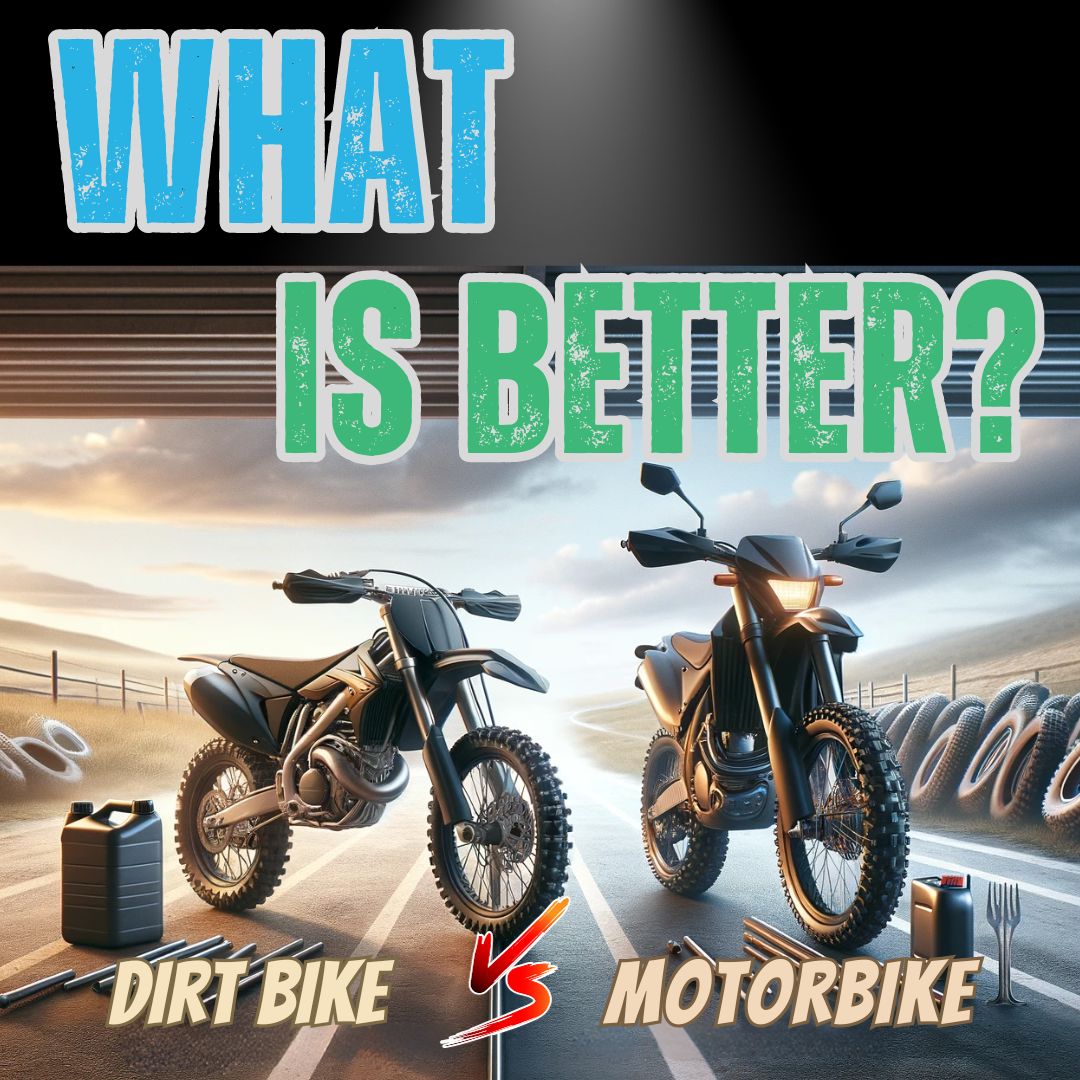
Updated: 27.05.25
Choosing between a motorcycle and a dirt bike depends on your riding goals. This guide compares their design, features, costs, and safety to help you decide.
1. Design and Purpose
| Feature | Motorcycle | Dirt Bike |
|---|---|---|
| Primary Use | Road travel, commuting | Off-road, motocross |
| Size and Weight | Larger, heavier | Lightweight, agile |
| Engine Power | High torque for speed | Optimized for terrain |
| Tires | Smooth for roads | Knobby for traction |
| Suspension | Stable for long rides | Agile for rough terrain |
Motorcycles are built for road efficiency, while dirt bikes excel in off-road agility.
2. Motorcycles: Road Warriors
Motorcycles prioritize comfort and speed for commuting or long-distance travel on paved roads. Their larger engines deliver high torque for highway performance.
Related: How to Ride a Motorcycle: A Beginner’s Guide
3. Dirt Bikes: Off-Road Champions
Dirt bikes are lightweight and nimble, designed for motocross and rugged terrain. They offer agility and control for thrilling off-road adventures.
4. Construction and Features
- Tires: Motorcycles use smooth tires for road grip; dirt bikes have knobby tires for off-road traction.
- Suspension: Motorcycles offer stable suspension for comfort; dirt bikes have agile suspension for jumps and bumps. Learn more about dirt bike suspension.
- Handlebars: Dirt bikes feature wide handlebars for control; motorcycles have shorter ones for streamlined steering.
- Posture: Dirt bikes require an erect posture with frequent clutch use; motorcycles allow a leaning posture with less clutch engagement.
- Brakes: Dirt bikes have sharp brakes for sudden stops; motorcycles use stable brakes for gradual slowing.
5. Riding Experience
Motorcycles provide speed and comfort for road trips, while dirt bikes offer agility and excitement on trails. Dirt bikes demand more clutch use and feature extra riding pegs for control.
6. Cost Considerations
| Bike Type | Category | Price Range | Typical Features |
|---|---|---|---|
| Motorcycle | Beginner Riders | £3,700–£7,400 | Lower power, stable handling |
| Experienced Riders | £7,400–£25,900 | High performance, advanced safety | |
| Used Motorcycles | Varies | Cost-effective, model-dependent | |
| Dirt Bike | Small Capacity (50cc) | £700–£2,100 | Lightweight, beginner-friendly |
| Medium Capacity (125cc) | £2,100–£5,600 | Moderate power, versatile | |
| Large Capacity (250cc–450cc) | £5,600–£7,000+ | Powerful, rugged design | |
| Kids’ Dirt Bikes | £89–£899 | Safe, low-power, fun |
For kids, RiiRoo offers affordable dirt bikes like the RiiRoo MXross 2.0 MotorCross Ride-on Motorbike 6V (£89–£99) for young enthusiasts.
7. 2025 Innovations in Motorcycles and Dirt Bikes
- Adaptive Cruise Control (ACC): Adjusts speed for safe distances (BMW, Ducati).
- Electric Powertrains: Eco-friendly with extended range.
- Electronic Suspension: Auto-adjusts for comfort (Kawasaki’s KECS).
- Traction Control: Enhances grip on dirt bikes.
- Smart Helmets: Feature HUDs and cameras for safety.
8. Maintenance and Upkeep
Motorcycles require regular oil changes and tire checks for road use. Dirt bikes need frequent servicing due to rough terrain but have simpler mechanics for DIY repairs. 10 Essential Tips for Maintaining Your Kid’s Motorcycle.
9. Lifestyle Fit
Motorcycles suit urban commuters and road trippers, offering efficiency and style. Dirt bikes are ideal for rural adventurers seeking off-road thrills.
10. Safety Measures
- Protective Gear: Full-face helmets, armored jackets, gloves, and boots.
- Defensive Riding: Stay alert, maintain safe distances, and use signals.
- Maintenance: Regularly check brakes, tires, and lights.
- Advanced Features: Use ABS, traction control, and adaptive headlights.
- Weather Awareness: Avoid riding in severe conditions.
Conclusion
Choose a motorcycle for road efficiency or a dirt bike for off-road excitement. Consider your lifestyle, budget, and safety needs to find the perfect ride.
Frequently Asked Questions
What safety features should I prioritize for family use?
Look for ABS, traction control, and sturdy frames. Ensure helmets and gear meet DOT/ECE standards, and provide rider training.
Which is better for commuting: motorcycle or dirt bike?
Motorcycles are ideal for city and highway commuting due to comfort and stability. Dirt bikes suit off-road routes but are less practical for roads.
Are dirt bikes suitable for family activities?
Yes, with proper sizing, safety gear, and training. Use designated trails for safe, fun family outings.
How do maintenance needs differ?
Motorcycles need regular road maintenance (oil, tires). Dirt bikes require frequent checks (filters, suspension) but are simpler for DIY fixes.
How can I save on motorcycle or dirt bike costs?
Buy used models, maintain bikes yourself, and invest in durable gear to reduce long-term expenses.







Share:
How Fast Are Dirt Bikes?
A New Dirt Bike for My Kids: Where Should We Go for the Best Rides?